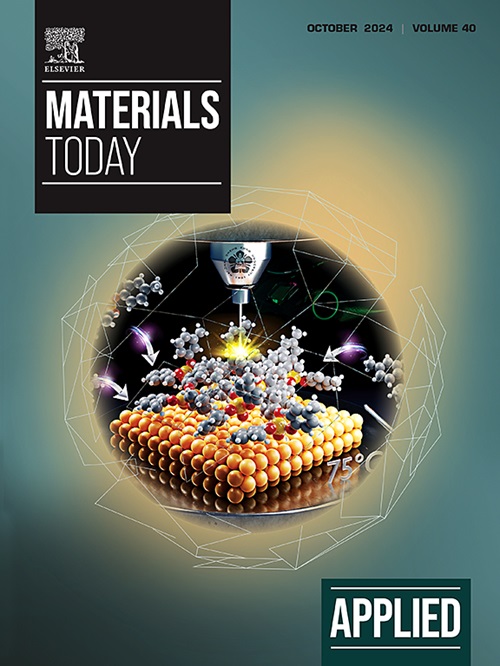Nanozyme-enhanced mitophagy to improve the efficacy of mesenchymal stem cells in myocardial infarction therapy
IF 6.9
2区 材料科学
Q1 MATERIALS SCIENCE, MULTIDISCIPLINARY
引用次数: 0
Abstract
Mesenchymal stem cell therapy has emerged as a promising approach for the treatment of myocardial infarction. However, the challenge of low cell survival and retention post injection, particularly under the high levels of reactive oxygen species (ROS) and oxidative stress at the infarct site, has hindered their clinical application. Additionally, traditional drug delivery methods, such as intravenous injection, cannot meet the demand for long-term stem cell residence at the infarct site, which is another critical issue that impedes the therapeutic efficacy of stem cells. Herein, we synthesized indocyanine green-enriched Prussian blue nanozyme, called PB@PEI@ICG, which not only possessed remarkable ROS scavenging capability but also exhibited superior fluorescent tracer property. Subsequently, we engineered mesenchymal stem cells (MSCs) with PB@PEI@ICG by co-culture and found that the introduction of the nanozyme significantly enhanced mitophagy by BNIP3 and PINK1 pathways, which in turn promoted ROS scavenging and protected MSCs from cell death induced by the harsh infarct microenvironment. Furthermore, we employed pericardial injection as an alternative delivery method to prolong the residence time of MSCs at the infarct site, enabling real-time tracking via the fluorescence property of the nanozymes. The results demonstrated that PB@PEI@ICG nanozyme could significantly improve the survival and retention of MSCs at the infarct site, thereby enhancing the therapeutic effect for myocardial infarction. In conclusion, this study presents a novel strategy for stem cell therapy in myocardial infarction by using mitophagy-enhancing nanozyme to scavenge ROS for enhancing the therapeutic potential of stem cells.纳米酶增强有丝分裂,提高间充质干细胞在心肌梗死治疗中的疗效
间充质干细胞疗法已成为治疗心肌梗塞的一种有前途的方法。然而,注射后细胞存活率和保留率低,特别是在梗塞部位活性氧(ROS)和氧化应激水平较高的情况下,这一难题阻碍了干细胞的临床应用。此外,静脉注射等传统给药方法无法满足干细胞在梗死部位长期存活的要求,这也是阻碍干细胞疗效的另一个关键问题。在此,我们合成了富含吲哚菁绿的普鲁士蓝纳米酶,即PB@PEI@ICG,它不仅具有显著的清除ROS能力,还表现出卓越的荧光示踪特性。随后,我们用 PB@PEI@ICG 与间充质干细胞(MSCs)共培养,发现纳米酶的引入能显著增强 BNIP3 和 PINK1 通路的有丝分裂,进而促进 ROS 清除,保护间充质干细胞免受恶劣梗死微环境诱导的细胞死亡。此外,我们还采用了心包注射作为一种替代给药方法,以延长间充质干细胞在梗死部位的停留时间,并通过纳米酶的荧光特性进行实时追踪。结果表明,PB@PEI@ICHG 纳米酶能显著提高间充质干细胞在梗死部位的存活率和存留率,从而增强对心肌梗死的治疗效果。总之,本研究提出了一种干细胞治疗心肌梗塞的新策略,即利用有丝分裂吞噬增强纳米酶清除ROS,从而提高干细胞的治疗潜力。
本文章由计算机程序翻译,如有差异,请以英文原文为准。
求助全文
约1分钟内获得全文
求助全文
来源期刊

Applied Materials Today
Materials Science-General Materials Science
CiteScore
14.90
自引率
3.60%
发文量
393
审稿时长
26 days
期刊介绍:
Journal Name: Applied Materials Today
Focus:
Multi-disciplinary, rapid-publication journal
Focused on cutting-edge applications of novel materials
Overview:
New materials discoveries have led to exciting fundamental breakthroughs.
Materials research is now moving towards the translation of these scientific properties and principles.
文献相关原料
公司名称
产品信息
麦克林
Sodium chloride
麦克林
Potassium ferrocyanide
麦克林
Iron (III) chloride hexahydrate
阿拉丁
Indocyanine green
阿拉丁
Anhydrous citric acid
阿拉丁
Methylene blue
 求助内容:
求助内容: 应助结果提醒方式:
应助结果提醒方式:


